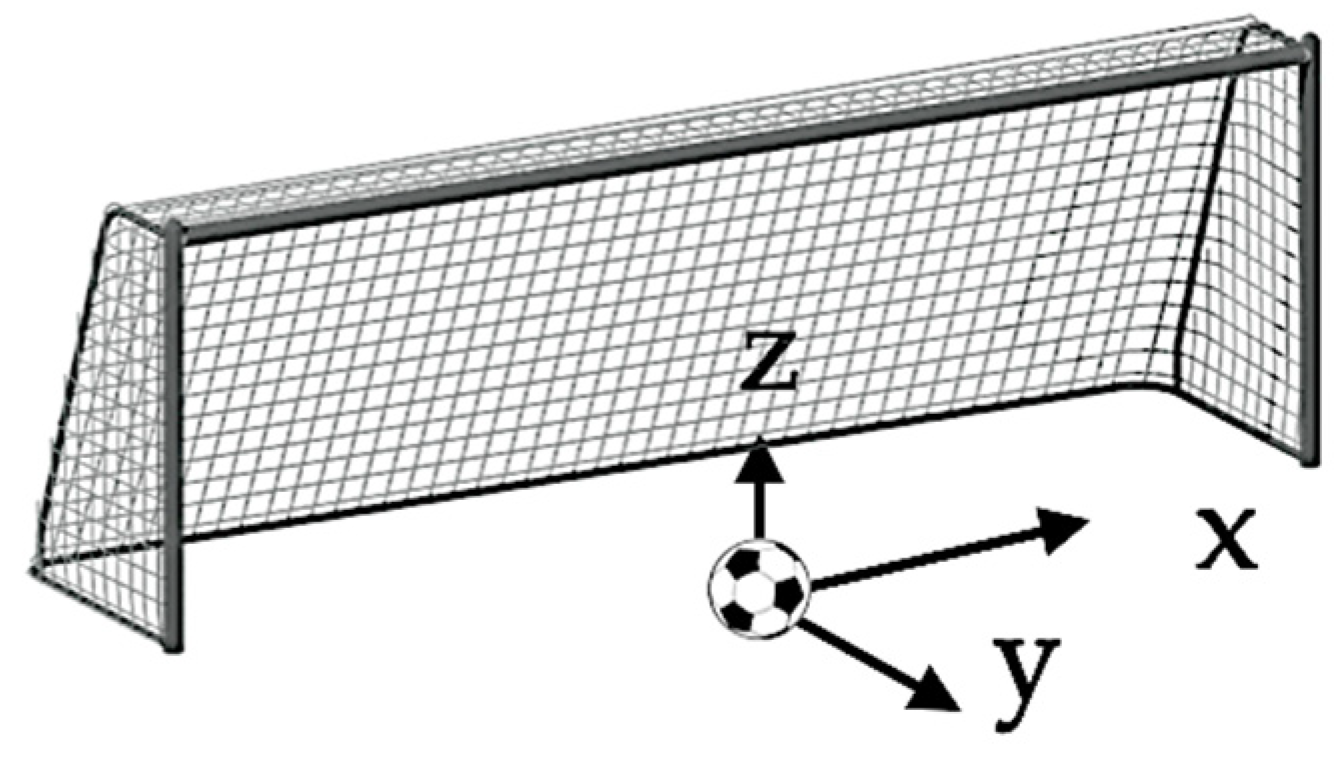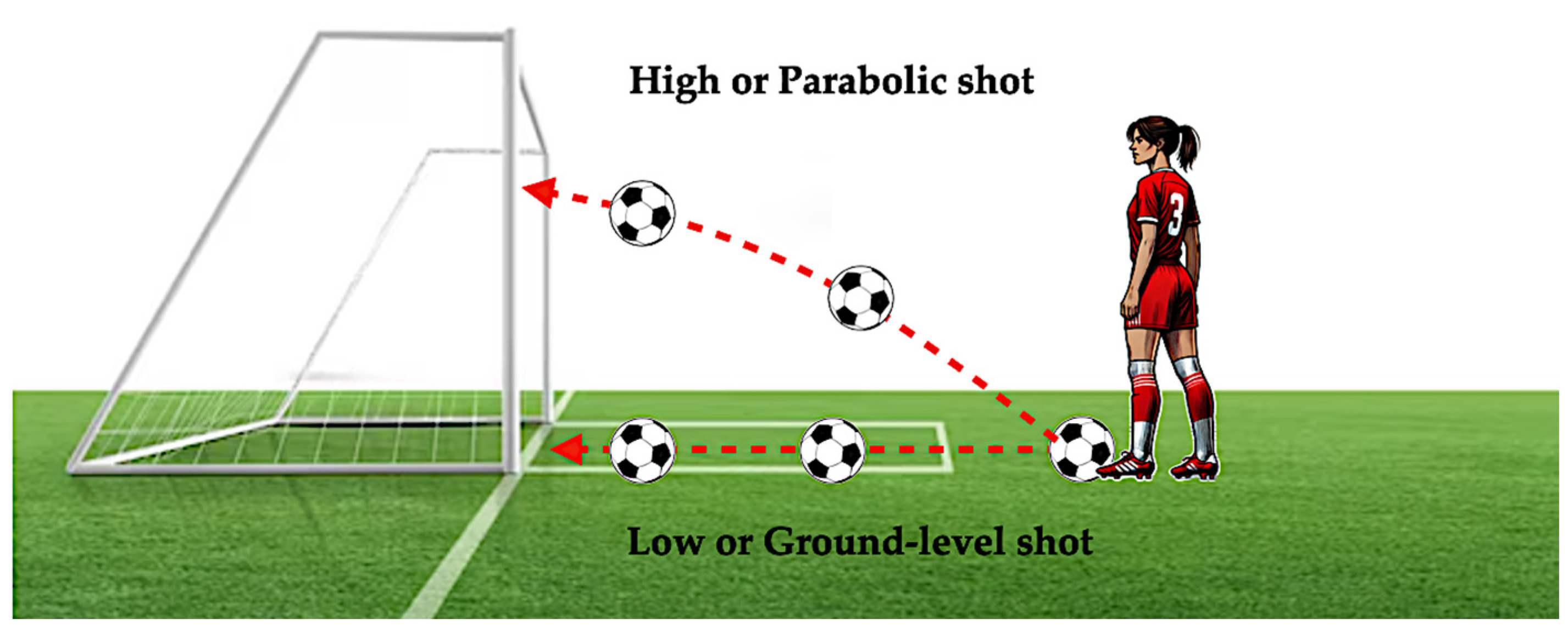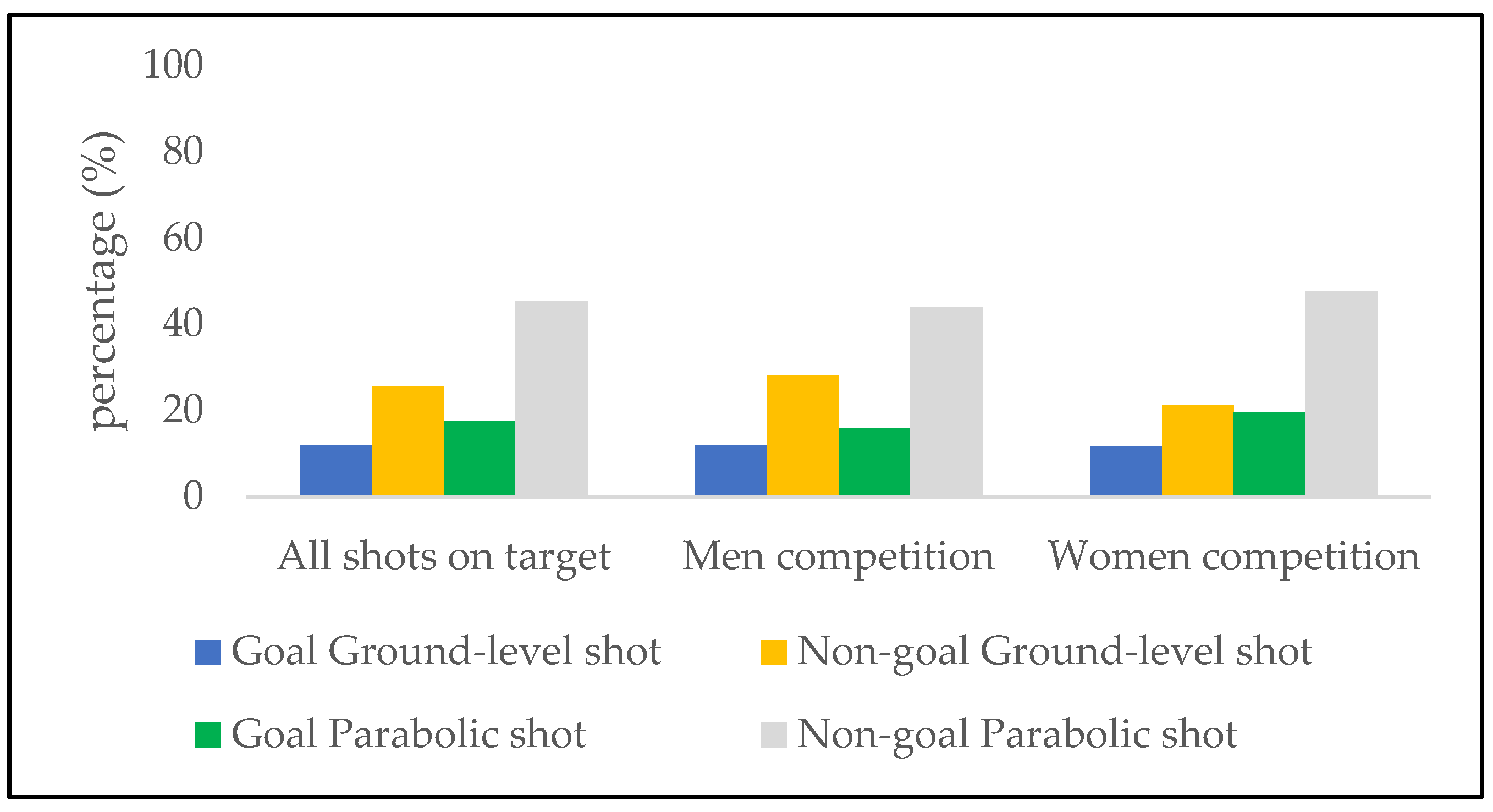Analysis of Shots Trajectory and Effectiveness in Women’s and Men’s Football European Championship Matches
Abstract
1. Introduction
2. Materials and Methods
2.1. Sample
2.2. Variables
2.3. Statistical Analysis
3. Results
4. Discussion
4.1. Practical Applications
- -
- For shooters: the objective should be to place shots accurately in the designated target zones.
- -
- For GKs: The goal should be to anticipate and block these shots effectively.
- -
- Scoring system: shooters earn points for successfully placing shots in the target areas; GKs earn points for each successful save; the player with the highest score at the end of the session would be the winner.
4.2. Limitations of the Study
5. Conclusions
Author Contributions
Funding
Institutional Review Board Statement
Informed Consent Statement
Data Availability Statement
Conflicts of Interest
References
- Stafylidis, A.; Mandroukas, A.; Michailidis, Y.; Vardakis, L.; Metaxas, I.; Kyranoudis, A.E.; Metaxas, T.I. Key performance indicators predictive of success in soccer: A comprehensive analysis of the Greek Soccer League. J. Funct. Morphol. Kinesiol. 2024, 9, 107. [Google Scholar] [CrossRef] [PubMed]
- Prieto-González, P.; Martín, V.; Pacholek, M.; Sal-de-Rellán, A.; Marcelino, R. Impact of offensive team variables on goal scoring in the first division of the Spanish soccer league: A comprehensive 10-year study. Sci. Rep. 2024, 14, 25231. [Google Scholar] [CrossRef] [PubMed]
- Broich, H.; Mester, J.; Seifriz, F.; Yue, Z. Statistical analysis for the First Bundesliga in the current soccer season. Prog. Appl. Math. 2014, 7, 1–8. [Google Scholar]
- Park, Y.S.; Choi, M.S.; Bang, S.Y.; Park, J.K. Analysis of shots on target and goals scored in soccer matches: Implications for coaching and training goalkeepers. S. Afr. J. Res. Sport Phys. Educ. Recreat. 2016, 38, 123–137. [Google Scholar]
- Rathke, A. An examination of expected goals and shot efficiency in soccer. J. Hum. Sport Exerc. 2017, 12, 514–529. [Google Scholar] [CrossRef]
- Barreira, J.; Vendite, C.; Vendite, L.L. Analysis of shots and passing sequence of a soccer team and its opponents during 2014 Brazilian championship. Int. J. Sports Sci. 2016, 6, 163–167. [Google Scholar]
- Yue, Z.; Broich, H.; Mester, J. Statistical analysis for the soccer matches of the First Bundesliga. Int. J. Sports Sci. Coach. 2014, 9, 553–560. [Google Scholar] [CrossRef]
- Kubayi, A. The creation of goal-scoring opportunities at the 2019 FIFA Women’s World Cup. J. Hum. Kinet. 2022, 82, 165–172. [Google Scholar] [CrossRef]
- Wright, C.; Atkins, S.; Polman, R.; Jones, B.; Sargeson, L. Factors associated with goals and goal scoring opportunities in professional soccer. Int. J. Perform. Anal. Sport 2011, 11, 438–449. [Google Scholar] [CrossRef]
- Stafylidis, A.; Michailidis, Y.; Mandroukas, A.; Gissis, I.; Metaxas, T. Analysis of goal scoring and performance indicators in the 2020-2021 Greek soccer league. J. Phys. Educ. Sport 2022, 22, 91–99. [Google Scholar]
- González-Ródenas, J.; López-Bondia, I.; Aranda-Malavés, R.; Tudela Desantes, A.; Sanz-Ramírez, E.; Aranda, R. Technical, tactical and spatial indicators related to goal scoring in European elite soccer. J. Hum. Sport Exerc. 2019, 15, 186–201. [Google Scholar] [CrossRef]
- González-Rodenas, J.; Lopez-Bondia, I.; Calabuig, F.; Pérez-Turpin, J.A.; Aranda, R. Association between playing tactics and creating scoring opportunities in counterattacks from United States Major League Soccer games. Int. J. Perform. Anal. Sport 2016, 16, 737–752. [Google Scholar] [CrossRef]
- Michailidis, Y.; Mandroukas, A.; Vardakis, L.; Metaxas, T. Evaluation of the goals scoring patterns and the relation between time and goal scoring of four UEFA Champions League tournaments. Facta Univ. Ser. Phys. Educ. Sport 2018, 16, 329–336. [Google Scholar] [CrossRef]
- Michailidis, Y.; Papadopoulos, P.; Mandroukas, A.; Metaxas, I.; Metaxas, T. The characteristics of counterattacks in the Spanish league (La Liga) in 2021–2022. J. Sports Med. Phys. Fit. 2023, 64, 37–44. [Google Scholar] [CrossRef] [PubMed]
- Paixão, P.; Sampaio, J.; Almeida, C.H.; Duarte, R. How does match status affect the passing sequences of top-level European soccer teams? Int. J. Perform. Anal. Sport 2015, 15, 229–240. [Google Scholar] [CrossRef]
- Redwood-Brown, A. Passing patterns before and after goal scoring in F.A. Premier League Soccer. Int. J. Perform. Anal. Sport 2008, 8, 172–182. [Google Scholar]
- Davis, J.; Robberechts, P. How data availability affects the ability to learn good xG models. In Proceedings of the 7th International Workshop of Machine Learning and Data Mining for Sports Analytics, Ghent, Belgium, 14–18 September 2020; pp. 17–27. [Google Scholar]
- Brechot, M.; Flepp, R. Dealing with randomness in match outcomes: How to rethink performance evaluation in European club football using expected goals. J. Sports Econ. 2020, 21, 335–362. [Google Scholar] [CrossRef]
- Mead, J.; O’Hare, A.; McMenemy, P. Expected goals in football: Improving model performance and demonstrating value. PLoS ONE 2023, 18, e0282295. [Google Scholar] [CrossRef]
- Cavus, M.; Stando, A.; Biecek, P. Glocal explanations of expected goal models in soccer. arXiv 2023, arXiv:2308.15559. [Google Scholar]
- Goodman, M. A New Way to Measure Keepers’ Shot Stopping: Post-Shot Expected Goals. 2018. Available online: https://statsbomb.com/2018/11/a-new-way-to-measure-keepers-shot-stopping-post-shot-expected-goals/ (accessed on 22 June 2024).
- Baron, E.; Sandholtz, N.; Pleuler, D.; Chan, T.C.Y. Miss it like Messi: Extracting value from off-target shots in soccer. J. Quant. Anal. Sports 2024, 20, 37–50. [Google Scholar] [CrossRef]
- Whitmore, J. What are Expected Goals on Target (xGOT)? 2021. Available online: https://theanalyst.com/eu/2021/06/what-are-expected-goals-on-target-xgot/ (accessed on 27 October 2024).
- Ruiz-de-Alarcón-Quintero, A.; De-la-Cruz-Torres, B. An expected goals on target (xGOT) metric as a new metric for analyzing elite soccer player performance. Data 2024, 9, 102. [Google Scholar] [CrossRef]
- De-la-Cruz-Torres, B.; Navarro-Castro, M.; Ruiz-de-Alarcón-Quintero, A. Leveraging the chain on goals model in football: Applications for attack and defensive play. Appl. Sci. 2025, 15, 998. [Google Scholar] [CrossRef]
- De-la-Cruz-Torres, B.; Navarro-Castro, M.; Ruiz-de-Alarcón-Quintero, A. The influence of goalkeepers’ height on soccer performance: A gender-based analysis. Int. J. Sports Sci. Coach. 2025; in press. [Google Scholar] [CrossRef]
- Anzer, G.; Bauer, P. A goal scoring probability model for shots based on synchronized positional and event data in football (soccer). Front. Sports Act. Living. 2021, 3, 624475. [Google Scholar] [CrossRef] [PubMed]
- Degrenne, O.; Carling, C. Comparison of goals scoring patterns between the 2018 and 2022 FIFA World Cups. Front. Sports Act. Living. 2024, 6, 1394621. [Google Scholar] [CrossRef]
- Ward, M.; Passmore, W.; Spencer, A.; Tuplin, S.; Harland, A. Characterization of football trajectories for assessing flight performance. Proc. Inst. Mech. Eng. Part P J. Sports Eng. Technol. 2019, 233, 140–151. [Google Scholar]
- Huldstatsbomb. Available online: https://github.com/statsbomb/open-data/blob/master/data/competitions.json (accessed on 3 February 2025).
- Dupeux, G.; Cohen, C.; Clanet, C. Football Curves. J. Fluids. Struct. 2011, 27, 659–667. [Google Scholar] [CrossRef]
- Liu, H.; Hopkins, W.; Gómez-Ruano, M.A.; Molinuevo, J.S. Inter-operator reliability of live football match statistics from OPTA Sportsdata. Int. J. Perform. Anal. Sport 2013, 13, 803–821. [Google Scholar] [CrossRef]
- Linke, D.; Link, D.; Lames, M. Football-specific validity of TRACAB’s optical video tracking systems. PLoS ONE 2020, 15, e0230179. [Google Scholar] [CrossRef]
- FIFA Quality Programme for Football Turf: Test Manual II: Test Requirements. Available online: https://inside.fifa.com/innovation/standards/football-turf/new-edition-of-fifa-test-manual (accessed on 29 January 2025).
- De-La-Cruz-Torres, B.; Navarro-Castro, M.; Ruiz-De-Alarcón-Quintero, A. An Expected Goals on Target (xGOT) Model: Accounting for Goalkeeper Performance in Football. Big Data Cogn. Comput. 2025, 9, 64. [Google Scholar] [CrossRef]
- Pettersen, S.; Johansen, D.; Dagenborg, H.; Berg-Johansen, V.; Gaddam, V.; Mortensen, A.; Langseth, R.; Griwodz, C.; Stensland, H.; Halvorsen, P. Soccer Video and Player Position Dataset. In Proceedings of the 5th ACM Multimedia Systems Conference, MMSys 2014, Stellenbosch, South Africa, 31 March–3 April 2025. [Google Scholar]
- Dagenborg, H.; Pettersen, S.; Halvorsen, P.; Johansen, D. Combining Video and Player Telemetry for Evidence-Based Decisions in Soccer. In Proceedings of the International Congress on Sports Science Research and Technology Support, icSPORTS 2013, Algarve, Portugal, 20–22 September 2013. [Google Scholar]
- Medbø, J.I.; Ylvisåker, E. Examination of the ZXY Arena Tracking System for Association Football Pitches. Sensors 2023, 23, 3179. [Google Scholar] [CrossRef] [PubMed]



| Variable of the Study | |
|---|---|
| Variable | Definition |
| Total shots on target | Total number of shots on goal, excluding penalty kicks and own goals |
| Goal shots | Total number of goals scored |
| Non-goal Shots | Total number of shots on goal that did not result in goals |
| Shot on target (xGOT) | Probability of a goal after considering shot placement and GK positioning |
| Classification of shot on target type | |
| Parameters | Definition |
| Ball start location | : the location of the ball before the shot (unit: meters). |
| Ball end location | : the location of the ball at the final part of the shot (unit: meters). |
| Shooting technique, | Name of the technique used for the shot, differentiating between:
|
| Shot Types | Head | Standard | Lob | Volley | High-Volley | Backheel | Dividing Header | Overhead Kick | Total |
|---|---|---|---|---|---|---|---|---|---|
| Women competition | 61 | 179 | 3 | 14 | 31 | 3 | 1 | 0 | 292 |
| Men competition | 61 | 321 | 2 | 19 | 44 | 2 | 1 | 1 | 451 |
| Total | 122 | 500 | 5 | 33 | 75 | 5 | 2 | 1 | 743 |
| Type of Shot on Target | All Shots on Target (n = 743) | Men Competition (n = 451) | Women Competition (n = 292) | Absolute Difference | ||||
|---|---|---|---|---|---|---|---|---|
| Goal Shots | Non-Goal Shots | Goal Shots | Non-Goal Shots | Goal Shots | Non-Goal Shots | Goal Shots | Non-Goal Shots | |
| Ground-level shot | 88 (11.84%) | 189 (25.44%) | 54 (11.97%) | 127 (28.17%) | 34 (11.64%) | 62 (21.23%) | 0.33% | 7.28% |
| Parabolic shot | 129 (17.36%) | 337 (45.36) | 72 (15.96%) | 198 (43.90%) | 57 (19.52%) | 139 (47.60%) | 3.56% | 3.70% |
| Type of Shot on Target | All Shots on Target (n = 743) | Men Competition (n = 451) | Women Competition (n = 292) | Difference of Mean | Confidence Intervals | |||||
|---|---|---|---|---|---|---|---|---|---|---|
| Goal Shots | Non-Goal Shots | Goal Shots | Non-Goal Shots | Goal Shots | Non-Goal Shots | Goal Shots | Non-Goal Shots | Goal Shots | Non-Goal Shots | |
| Ground-level shot | 0.36 ± 0.08 | 0.12 ± 0.02 | 0.36 ± 0.08 | 0.11 ± 0.01 | 0.35 ± 0.07 | 0.13 ± 0.02 | −0.004 | 0.017 | (−0.1250, 0.1174) | (−0.0282, 0.0627) |
| Parabolic shot | 0.30 ± 0.07 | 0.09 ± 0.02 | 0.32 ± 0.08 | 0.10 ± 0.02 | 0.28 ± 0.06 | 0.08 ± 0.01 | −0.047 | −0.019 | (−0.1406, 0.0472) | (−0.0464, 0.0075) |
Disclaimer/Publisher’s Note: The statements, opinions and data contained in all publications are solely those of the individual author(s) and contributor(s) and not of MDPI and/or the editor(s). MDPI and/or the editor(s) disclaim responsibility for any injury to people or property resulting from any ideas, methods, instructions or products referred to in the content. |
© 2025 by the authors. Licensee MDPI, Basel, Switzerland. This article is an open access article distributed under the terms and conditions of the Creative Commons Attribution (CC BY) license (https://creativecommons.org/licenses/by/4.0/).
Share and Cite
De-la-Cruz-Torres, B.; Navarro-Castro, M.; Ruiz-de-Alarcón-Quintero, A. Analysis of Shots Trajectory and Effectiveness in Women’s and Men’s Football European Championship Matches. Big Data Cogn. Comput. 2025, 9, 157. https://doi.org/10.3390/bdcc9060157
De-la-Cruz-Torres B, Navarro-Castro M, Ruiz-de-Alarcón-Quintero A. Analysis of Shots Trajectory and Effectiveness in Women’s and Men’s Football European Championship Matches. Big Data and Cognitive Computing. 2025; 9(6):157. https://doi.org/10.3390/bdcc9060157
Chicago/Turabian StyleDe-la-Cruz-Torres, Blanca, Miguel Navarro-Castro, and Anselmo Ruiz-de-Alarcón-Quintero. 2025. "Analysis of Shots Trajectory and Effectiveness in Women’s and Men’s Football European Championship Matches" Big Data and Cognitive Computing 9, no. 6: 157. https://doi.org/10.3390/bdcc9060157
APA StyleDe-la-Cruz-Torres, B., Navarro-Castro, M., & Ruiz-de-Alarcón-Quintero, A. (2025). Analysis of Shots Trajectory and Effectiveness in Women’s and Men’s Football European Championship Matches. Big Data and Cognitive Computing, 9(6), 157. https://doi.org/10.3390/bdcc9060157







